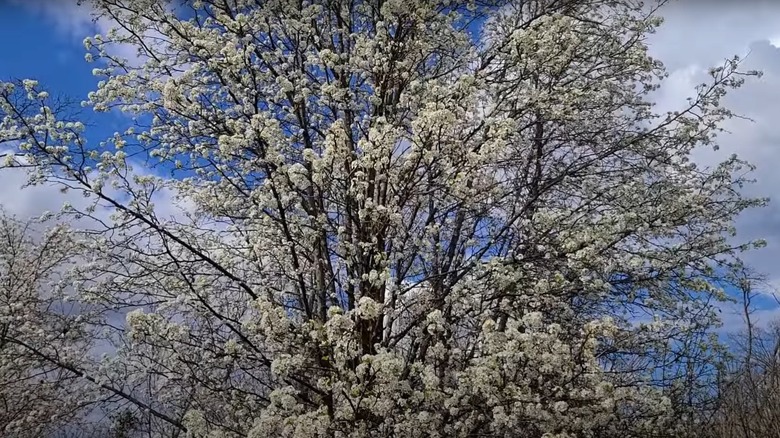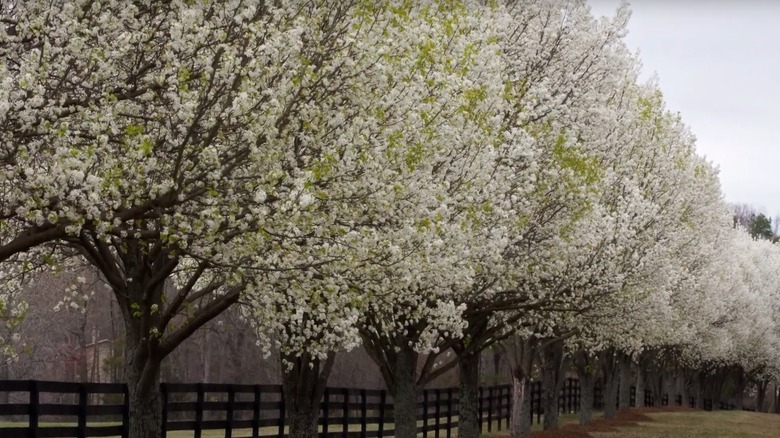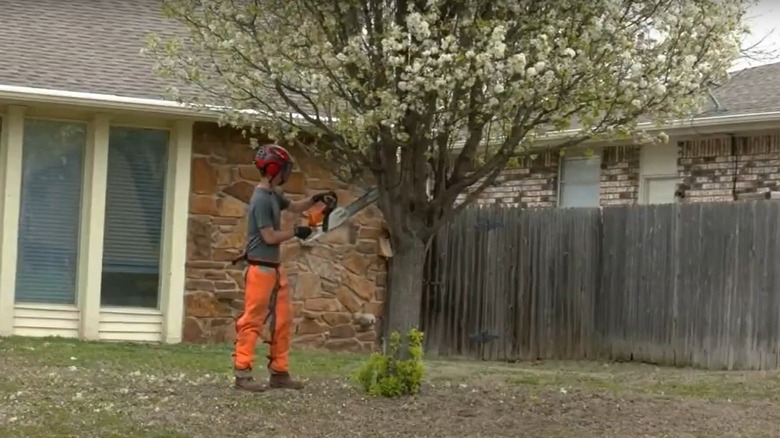The Worst Tree To Plant In Your Midwestern Yard
When you want to plant a new tree at your property, you probably think about a lot of things. If you want a species that will be beautiful, flowering trees can be perfect for your yard. However, you need to pay attention to more than just the color and timeliness of the blooms. You'll want to watch the hardiness of the tree, especially if you live in an area that has storms. Some trees are more susceptible to limb damage during windstorms than others. One flowering tree that does not stand up well to harsh weather conditions – making it one of the worst trees to plant in the stormy Midwestern climate – is the Bradford pear tree.
Bradford pears do have a beautiful bloom consisting of creamy white flowers with a yellow center, which makes them attractive and tempting to plant. The blooms may last about two weeks in the early spring. It's also a beautiful tree in the autumn when the leaves turn orange and deep red.
However, Bradford pears are poor trees to plant for a variety of reasons, including because of weak branch structures. During windstorms in the Midwest, the trunk may split or large limbs may crack, ruining the tree. Because the Bradford pear could reach 50 feet in height, large broken limbs could fall on your roof and cause significant damage. Falling limbs could cause injuries or fatalities, too. Beyond the danger of broken limbs in windstorms, you may want to avoid planting this species at your Midwest home due to the foul-smelling fruit, the short life expectancy, and the aggressive nature of the tree.
Other issues with the problematic Bradford pear tree
Unfortunately, there isn't much you can do to prevent Bradford pear trees from being one of the worst trees to put in your yard in the Midwest. Even if you do everything perfectly, including properly preparing your yard's soil before planting, the Bradford pear's weak structure will still be problematic in windy weather. Another major drawback when planting Bradford pears is their short lifespan. Even if the tree doesn't die from storm damage, its expected lifespan is only 20 years. It frequently dies off earlier than 20 years because of its susceptibility to diseases like fire blight and leaf spot.
Although Bradford pears have beautiful flowers for a couple of weeks, you might not want to get too close to the blooms. Many people describe this species as having an odor that resembles rotting fish. The unpleasant odor often draws flies, which serve to pollinate the tree. However, you probably don't want these insects invading your yard and potentially exposing your family to the diseases they carry.
The thorny, dense branches of the Bradford pear allow it to choke out more desirable trees like pines and dogwoods. This is considered an invasive species in many states because it reproduces quickly. Several states have even banned the Bradford pear because of its designation as an invasive species. Missouri has offered a program in the past that awards free replacement trees to private property owners who cut down their Bradford pear trees. If you can't benefit from this type of program, expect to pay around $750 to have the tree removed.
What similar alternatives can you plant instead of Bradford pear trees?
Fortunately, there are multiple alternatives to the Bradford pear tree that you can plant. If you want another tree that has an early spring white bloom, you could try the serviceberry, which grows well in nearly the entire Midwest, other than near the Canadian border. It's not quite as large as the Bradford pear, usually topping out at up to 25 feet in height, but it also has beautiful leaf colors in autumn of gold and reddish-orange.
Another option is the white dogwood, which has white flowers in spring and grows well throughout the Midwest, other than in northern Minnesota and North Dakota. It has a height at maturity of up to 25 feet. This is a beneficial tree for your yard, as it prevents unwanted erosion and contributes to better soil conditions. Its leaves turn reddish-purple in the autumn, creating striking colors. It even has red fruit for a splash of color in winter.


